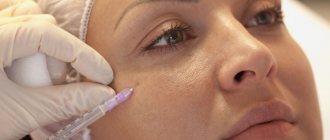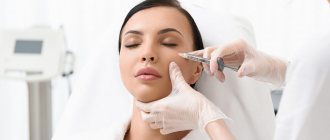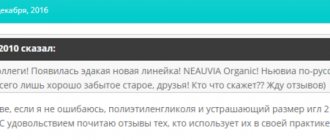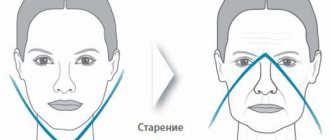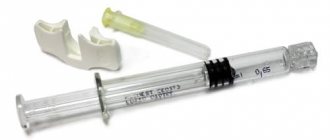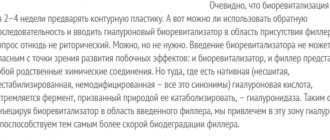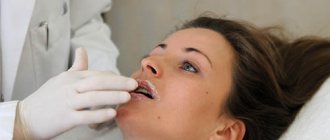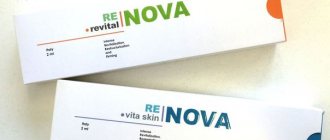In 2015, the Hyalual Switzerland Institute created and introduced to the cosmetic market a drug based on sodium hyaluronate and a salt of succinic acid - sodium succinate.
Hyaluronic acid is found in human nervous, connective and epithelial tissues. Succinic acid is also a product of human activity and takes an active part in metabolic processes. The combination of these two acids provides powerful effects:
- anti-inflammatory;
- antioxidant;
- moisturizing;
- restorative;
- enhancing microcirculation and metabolism in tissues;
- stimulating the synthesis of collagen and elastin.
Hyalual is a modern “elixir of youth” that promotes intensive skin restoration for a long time, making it fresh, radiant, flawless.
What is skin redermalization
Redermalization is a complex technique; it rejuvenates the middle layers of the skin, increasing their ability to regenerate. Thanks to the Hyalual drug, the effect of the procedure is comparable to mesotherapy, and also has significant differences from other short-term methods of rejuvenation: it regulates biochemical processes in skin cells and restores water balance.
Along with redermalization, the Clinic of Cosmetology and Dermatology “BL” performs a procedure similar in technique - hyalual biorevitalization. The difference between them is that biorevitalization is carried out by introducing low molecular weight hyaluronic acid under the skin without combining it with sodium succinate, as with redermalization.
Patients with rosacea cause certain difficulties in the work of a cosmetologist, since any aesthetic procedures can lead to an exacerbation of the disease. Injection correction of rosacea manifestations with the drug “Hialual” expands the possibilities of cosmetology for patients with this dermatosis. We bring to your attention the author's protocol.
Rosacea is a chronic skin disease characterized by the appearance of rashes on the facial skin.
The pathogenesis of dermatosis involves angioneurosis of the zone of innervation of the trigeminal nerve [1]. The treatment of this disease is mainly carried out by dermatologists, but in recent years, cosmetologists have been actively developing protocols for the management of patients with this disease. And this is not surprising, because the rashes are localized on the skin of the face - the “field of work” of a cosmetologist. They present as centrofacially located erythema, telangiectasia, papules, pustules, depending on the subtype and severity of the disease.
Drug of choice
Patients with rosacea (mainly subtypes 1 and 2) occupy a certain proportion among the cosmetologist’s patients. In these patients, injection and hardware procedures are carried out with caution - for fear of causing an exacerbation of rosacea. But the use of the drug “Hialual”, which combines hyaluronic and succinic acids, expands the range of procedures for patients with this diagnosis.
The pathogenesis of rosacea is based on inflammation initiated with the participation of TLR2 (Toll-like receptor, Toll-like receptors), keratinocytes, exposure to ultraviolet radiation, high and low temperatures, antigens (chitin shell of D. folliculorum, glycoproteins of B. oleronius), neuropeptides produced under stress (neuroimmune mechanisms), or the formation of viscero-cutaneous reflexes (7,8). The next step is the release of inflammatory proteases (matrix metalloproteinases, kallikrein kinases) and antimicrobial peptides (alpha-, beta-defensins and cathelicidin LL-37) (4).
Succinic acid acts on type 2 matrix metalloproteinases, reducing their activity, which leads to a decrease in inflammation.
Sodium succinate causes a short-term dilation of the peripheral blood vessels of the skin in the injection area immediately after administration. At the same time, through the mechanism of expression of succinate-dependent receptors on the vascular wall, it has a delayed vasoconstrictor effect. Which in general can be perceived as “training” of dilated vessels due to rosacea with a tendency to stable vasconstriction. The vasoconstrictor effect of succinate has been successfully used in related specialties, for example, in cardiology (3, 5).
Angioneurosis of the area of innervation of the trigeminal nerve leads to stagnation of blood in the dilated vessels of the facial skin and tissue hypoxia. Sodium succinate increases the affinity of hemoglobin for oxygen, facilitating the release of oxygen, which improves tissue oxygenation (3,6).
The listed mechanisms lead to a positive clinical effect of intradermal injection of Hyalual preparations (redermalization) in patients with rosacea in the form of a decrease in the brightness of erythema and the number of papules.
To correct the manifestations of rosacea, we have developed our own clinical protocol for redermalization (protocol by A.V. Reznik).
Data on the effect of succinic acid on the pathogenesis of rosacea are constantly expanding.
Author's protocol
We propose using 3 procedures of intradermal papular administration of the drug “Hyalual” in the facial area with an interval of two weeks.
During the first procedure, “Hialual” 1.1% is used, during the second – “Hialual” 1.8%, during the third – “Hialual” 2.2%. In all three versions of the drug, the concentration of sodium succinate is the same and is 16 mg/ml, only the concentration of hyaluronic acid differs: 11 mg/ml, 18 mg/ml and 22 mg/ml, respectively.
The use of the drug “Hialual” 1.1% with a minimum content of hyaluronic acid during the first procedure is justified by the goal of minimizing tissue edema, thereby “unloading” the vessels, reducing tissue hypoxia and creating the most favorable conditions for the expression of succinate-dependent receptors on the vessels and subsequent vasoconstriction.
Gradually increasing the concentration of hyaluronic acid in each subsequent procedure stimulates the gradual production of hyaluronidase type II (Hyal 2, intercellular hyaluronidase), causing the gradual destruction of high molecular weight hyaluronic acid and maintaining an optimal balance of hyaluronic acid in and outside the cell (2).
After completing the course, we recommend maintenance redermalization procedures every 2-3 months.
The concentration of hyaluronic acid in the preparation used for the procedure is dictated by the condition of the skin at the time of the procedure. When the number of papules increases and the brightness of the erythema increases, we recommend using “Hialual” 1.1%, in cases of continued remission – “Hialual” 1.8%.
Clinical case
Patient, 38 years old. Complaints of persistent redness of the facial skin when the ambient temperature changes, as well as rashes on the facial skin, periodic burning and tingling of the skin in these areas.
The above complaints have been troubling us for the last 8–10 years. Observed by a dermatologist, she was treated with a satisfactory clinical effect, but subsequent exacerbations. Examined by related specialists. He has noted a deterioration in the skin process over the last six months.
Objectively: combination skin type. Phototype according to Fitzpatrick – 2. Morphotype of aging according to Kolgunenko – mixed. On the skin of the forehead, temporal areas, cheeks, nose, chin there are foci of bright pink erythema, tree-like branched telangiectasias of various diameters, single pinkish-red papules up to 3 mm in diameter, no pustules. Diagnosis: rosacea, papulopustular subtype, moderate to severe course.
Against the background of adequately prescribed home care, redermalization of facial skin with a combined preparation of hyaluronic and succinic acids “Hialual” was proposed. The drug was administered intradermally, papularly, into the forehead, temples, cheeks and chin, after topical anesthesia. During the first procedure, the drug “Hialual” 1.1%, 1 ml was used, during the second - “Hialual” 1.8%, 1 ml, during the third - “Hialual” 2.2%, 2 ml, with an interval of two weeks.
The maximum concentration of hyaluronic acid during the final procedure of the course is necessary to create prolonged hydration of the skin in conditions of normal vascular function.
Correction result
After the course of redermalization, the patient subjectively noted a decrease in the number of eruptive elements. Objectively, a decrease in the brightness of the erythema and the number of papules was observed.
The patient was given recommendations for eliminating factors that provoke rosacea, home care, and was also prescribed a course of supportive redermalization procedures once every 2-3 months.
The evaluation of the results of the course of procedures was carried out on the basis of photographic data and positive dynamics in the skin process, noted subjectively by the patient. When comparing photographs taken before and after a course of procedures, a decrease in the brightness of facial skin erythema, the number and severity of papules was revealed.
Conclusion
Thus, redermalization with the drug “Hialual” according to the protocol of A. V. Reznik shows clinical effectiveness in patients with papulopustular, as well as erythematotelangiectatic subtypes of rosacea. And it can be recommended as part of a monocorrection and in combination with hardware and light methods for treating rosacea. And also as preparatory therapy in patients with rosacea before any traumatic cosmetic procedures.
Literature
- Arabian E. R., Samtsov A. V. Federal clinical guidelines for the management of patients with rosacea. Russian Society of Dermatovenereologists and Cosmetologists. 2015.
- Korobkova E., Ozerskaya A. Hyaluronic acid. Size matters: the dependence of cosmetic effect on the size of the hyaluronic acid molecule. Cosmetical tools. 2015. No. 1. pp. 52–62.
- Reznik A. Antioxidants or adaptogens. Kosmetik International. 2017. No. 5. pp. 122–125.
- Khairutdinov V.R. Rosacea: modern ideas about pathogenesis, clinical picture and treatment. Effective pharmacotherapy. 2014. T. 3. pp. 32–37.
- Aguiar CJ et al. Succinate modulates Ca2+transient and cardiomyocyte viability through PKA-dependent pathway. Cell calcium. 2010. T. 47. No. R. 37–46.
- Lukyanova LD Mitochondrial signaling in hypoxia. Open Journal of Endocrine and Metabolic Diseases. 2013. T. 3. No. 02. R. 20.
- Steinhoff M., Schauber J., Leyden JJ New insights into rosacea pathophysiology: a review of recent findings. J. Am. Acad. Dermatol. 2013. Vol. 69. No. 6. Suppl. 1. P. S15–26.
- Yamasaki K., Gallo RL Rosacea as a disease of cathelicidins and skin innate immunity. J. Investig. Dermatol. Symp. Proc. 2011. Vol. 15. No. 1. P. 12–15.
Authors: Anna Reznik, Alisa Yakhina
Magazine: Appearance. Esthetic guide №3(26)
Biorevitalization with Hyalual 1.8% in Yaroslavl
Biorevitalization with Hyalual 1.8%, 1 ml
The drug Hyalual® (Hyalual) 1.8% is developed on the basis of high molecular weight hyaluronic acid - 1.8% and succinic acid (sodium succinate) - 1.6%. This combination ensures the restoration of elasticity, firmness, texture and color of the skin. Hyalual® (Hyalual) 1.8% helps restore skin cells and eliminates signs of aging. This occurs due to significant restorative and antioxidant effects:
- stimulation of endogenous synthesis of collagen and hyaluronic acid due to migration and proliferation of fibroblasts;
- replenishment of hyaluronic acid deficiency, elimination of skin dehydration;
- stimulation of tissue metabolism by enhancing cellular respiration, protein synthesis, ion transport, activation of ATP formation.
- The drug Hyalual® (Hialual) 1.8% is widely used for comprehensive skin rejuvenation:
- returns healthy complexion,
- lightens pigment spots,
- improves skin color and texture,
- increases the elasticity of the skin,
- reduces the appearance of wrinkles.
The biorevitalization procedure with the drug Hyalual® (Hialual) 1.8% is recommended as a starting one in an anti-aging program for fine-wrinkled type of aging, and also participates in preparation for aggressive procedures (laser skin resurfacing, plastic surgery). The drug is prescribed for redermalization of the skin of patients aged 35 to 45 years. Indications for the biorevitalization procedure with Hyalual® (Hialual) 1.8%:
- as a starting procedure for finely wrinkled morphotype;
- the second stage in the program for correcting the tired, deformation-edematous, muscular morphotype of aging;
- dry, dehydrated skin;
- bioreinforcement;
- temporary filling (filling) of wrinkles;
- preparation for traumatic procedures;
- correction of photoaging, photodamage, dyschromia;
- redermalization of the skin of the hands.
Contraindications to the use of the drug Hyalual® (Hialual) 1.8%:
- tendency to form keloids;
- active inflammatory processes in the area of proposed therapy;
- tendency to bleed;
- undergoing thrombolytic and anticoagulant therapy over the past 2 weeks;
- pregnancy and lactation;
- increased sensitivity to hyaluronic acid;
- acute viral or bacterial infections and their symptoms (fever, chills, etc.).
Biorevitalization with Hyalual® (Hialual) 1.8% in Yaroslavl
Biorevitalization with Hyalual® 1.8% is one of the popular and highly effective cosmetic procedures that helps cope with skin problems in patients aged 35-45 years. Cosmetologists at the Center for Evidence-Based Medicine have extensive experience working with this drug and are happy to observe the processes of patient skin restoration, which occur thanks to a well-developed correction program and the high quality of the materials used, including the drug Hyalual® (Hialual) 1.8%.
Our cosmetologists are firmly convinced: beauty begins with healthy skin!
